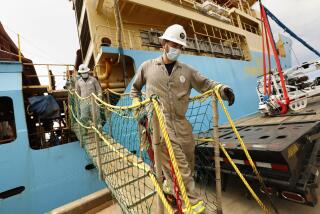Exotic microbe discovered in undersea aquifer
- Share via
There may be no more difficult place to hunt for exotic wildlife than the undersea aquifer oozing through cracks and fissures in porous rock hundreds of feet beneath the ocean floor.
Crushing pressures and the risk of contaminating samples with regular seawater while retrieving them from boreholes sharply limits efforts to document the distribution of life in what remains a largely uncharted environment.
Now, using a device that creates a seal in holes drilled in the ocean floor -- like a cork in a bottle -- a team of researchers from USC and the University of Hawaii has discovered a new species of sulfate-eating microorganism at the edge of the Juan de Fuca tectonic plate about 200 miles off the coast of Washington.
“One of the surprises of this effort,” said Alberto Robador, lead author of a study published Wednesday in the journal Frontiers in Microbiology, “was the discovery of a microorganism that is unique and thriving in a place seemingly inhospitable to life.”
These microbes gain energy by using sulfate – a compound of sulfur and oxygen – to oxidize decaying biological material that sinks to the bottom of the sea, then flows into the undersea aquifer via a variety of chemical and physical forces.
The study was made easier in the summer of 2010 with a Circulation Obviation Retrofit Kit, or CORK, which allowed the researchers to deploy sampling instruments and hoses down boreholes drilled 150 to 350 feet into the ocean crust without risk of contamination.
Aquifer water was pumped through the hoses into 50-liter sample bags made of polyvinyl fluoride film with heat-sealed, leak-proof seams. The bags were shuttled to the surface by remote-controlled “bio sleds,” then gently lifted aboard a research vessel.
The exotic microbe is one of myriad microscopic life forms that have established ecological niches in undersea aquifers, the largest aquifer system on Earth.
It may not only provide new insights into the natural cycling of carbon in the environment, but may also suggest what kinds of life to seek elsewhere in our solar system – and ways to collect them.
“This is certainly discovery science,” Jan Amend, a professor of microbial geochemistry at USC, said. “It’s about finding signs of life never detected before; be it on Earth, Mars, Jupiter’s ice-covered moon Europa or elsewhere.”
The research was funded by the National Science Foundation and the NASA Astrobiology Institute.
Follow me @LouisSahagun for more fascinating stories







